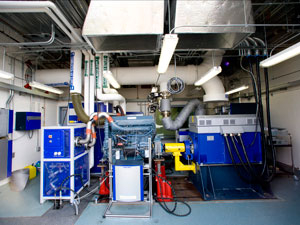The Texas Diesel Testing and Research Center at the University of Houston recently finished an expansion doubling its size and increasing its means to research and test retrofit devices that reduce the amount of harmful pollutants emitted from heavy-duty diesel engine exhaust.
The expansion, funded with a grant from the Texas Commission on Environmental Quality, cost more than $9 million and took roughly a year to complete. Located in what is now the University of Houston Energy Research Park, the diesel center occupies 12,000 square feet housing more office and functional laboratory space as well as advanced emission testing equipment.
“This grant really allowed us to expand as a center,” said Charles Rooks, director of the diesel center. “We are now able to do things few labs in the country are capable of accomplishing.”
Launched in 2003 with funding from the city of Houston, the diesel center spent their first years testing retrofit devices with only a chassis dynamometer—a type of treadmill for trucks.
“In our region, diesel vehicles emit about a third of the nitrogen oxides (NOx), which is known as the respiratory irritant in smog,” said Michael Harold, professor of chemical and biomolecular engineering and lead investigator on the grant. “Earlier in the decade the city of Houston administration recognized that the city needed to set an example for the private sector and help reduce its NOx emissions from its operations as well as help Houston become compliant with the U.S. Environmental Protection Agency’s Clean Air Act.”
So the diesel center went to work for the city testing a variety of retrofits—a cheaper alternative to completely replacing its older, dirtier diesel engines. The diesel center recommended technologies that properly and cost effectively cleaned up the city's diesel fleet.
“Officials in the city told us that we saved taxpayers millions of dollars and avoided expenses on technologies that frankly would not have worked or met the goal of reducing NOx,” Harold said.
Completed this month, the expansion takes the diesel center’s capabilities well beyond what could be done in these early years with the just the chassis dynamometer. It has doubled lab space used for research and technology development, data analysis and emission testing. The addition of a portable emission measurement system allows them to gather real-world data off site while the system is connected to a diesel vehicle.
But the real highlight, according to Harold, is a 600 horsepower heavy-duty diesel engine dynamometer. It’s the same piece of equipment the EPA uses to verify retrofit technologies prior to their commercialization.
“The heavy-duty engine dynamometer that has been installed with the state of Texas grant puts us in the league with some of the best labs in the world in terms of capabilities,” said Harold. “The engine dynamometer is a testing venue that the EPA requires for verification of technologies so this will open the door to many more potential partners and customers who will use it to evaluate their technologies using procedures that are defined by the EPA.”
The diesel center will begin testing retrofits on the machine later this year. Among first being tested is a Michigan-based company called Tinnerman/Shadowood. Like others who will follow, the diesel center will help them in determining whether they are ready to proceed with verification testing at the Southwest Research Institute, the final step before mass production of their technology.
Beyond this, there are machines allowing UH researchers to test fuels, additives and exhaust as well as determine the ability of a retrofit technology to improve fuel efficiency, which is sometimes sacrificed in an attempt to reduce pollutants.
And for the first time, these researchers can take their testing far from the lab more easily working with diesels classified as non-road—typically backhoes and other construction equipment. With the recent receipt of roughly $3 million in funding from the EPA, the team is already using their portable emission measurement system to test three separate retrofits—all classified as EPA emerging technologies that are trying to make the leap to get verified for commercialization.
The diesel team is traveling as far Corpus Christi to the south and Beaumont to the east to use their portable system to test Texas Department of Transportation fleets in normal operating conditions.
“This renovation is really going to change how we do things and what we are capable of accomplishing,” said Rachel Muncrief, research assistant professor with the diesel center. “Basically any diesel vehicle that puts out emissions, we can measure no matter where it might be in Texas.”
